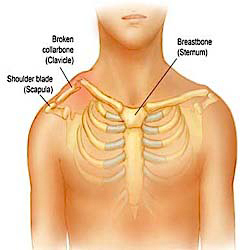 A clavicle fracture (collarbone) is a frequently broken bone in people of all ages, but especially those who participate sports. It is located between the ribcage and the shoulder. In effect, it connects the shoulder to the chest.
A clavicle fracture (collarbone) is a frequently broken bone in people of all ages, but especially those who participate sports. It is located between the ribcage and the shoulder. In effect, it connects the shoulder to the chest.
What Happens with Fracture in Clavicle?
The majority of broken collarbones occur because of accidents: being hit or falling on your shoulder, or falling on the arm at just the right angle, where the force is transferred to the collarbone, and the bone subsequently snaps. They are most often associated with bicycle falls and sports collisions. In some cases, the bone is broken during childbirth as the baby passes the birth canal.
Symptoms
You will know when you break a collarbone. There might be an audible snap. Afterward, there will be pain and swelling, difficulty moving the arm, a visible sagging of the shoulders, a noticeable bump where the bone fractured, and a grinding feeling when moving the limb.
What to Do
Go see a doctor! The clavicle fracture treatment begins with visiting a doctor or emergency room visit. The doctor may ask questions regarding the nature of the injury, or apparent symptoms. The doctor will take some x-rays to verify the extent of the fracture and potential damage to any joints. In some cases, the doctor will recommend a CT scan for more detail.
A word of caution: if arriving at an automotive accident or any situation where a broken clavicle is suspected, call the authorities and let them move the person, unless the patient must be moved to a safer location. In that case, avoid any movement of the neck, back, or collarbone.
Treatment and Management
It involves controlling the pain and protecting the injury.
1. Ice Packs and Medication for Pain
Pain management will occur with the combination of ice and medication. More often than not, the doctor will prescribe some pain medication like ibuprofen for the first week or two, in order to reduce the pain.
Ice packs, wrapped in cloth, are to be applied religiously for 2-3 days after the incident.
2. Sling and Support
The doctor will often require that the arm associated with the broken bone be placed in a sling to limit the movement of the bone. Additionally this provides arm support. In some cases, a splint will also be applied to keep the bone in place.
3. Surgery
Sometimes surgery is required as well. If the bone breaks through the skin, is broken into several places, or out of place, surgery may be recommended. Plates, screws, and rods are often used to ‘fix’ the bone in place and maintain the proper position of the bone for healing. In rare cases, surgery complications do occur, potentially resulting in a lack of healing of the bone or infections.
4. Follow-Up
Additionally, the doctor requires various check-ups to discuss the healing process. In many cases, physical therapy is often prescribed to help the healing process.
5. Complications
If the bone does not heal properly, some complications occur. If the bone does not match up, it results in a malunion (the fracture healed in less than an optimal position).
A common result of a clavicle fracture is a noticeable bump where the bone broke.
When Does It Feel Better?
It usually heals within 12 weeks. When an individual can move the arm without any pain and an x-ray has confirmed the healing, an individual is officially allowed to resume previous levels of physical activity.
Video that explains more about fracture in clavicle :
